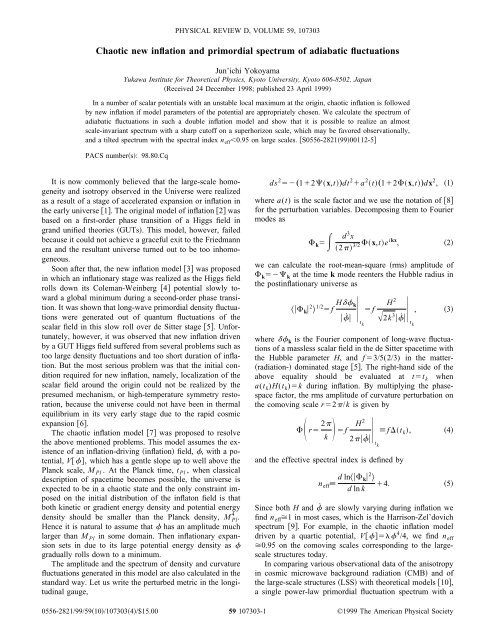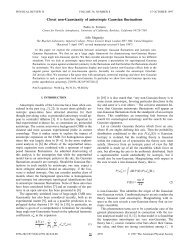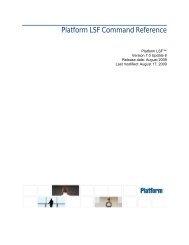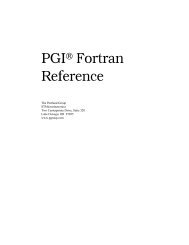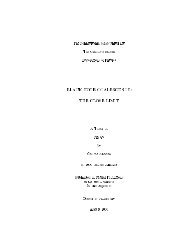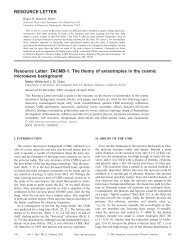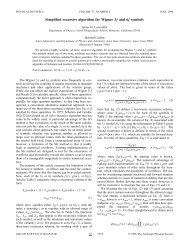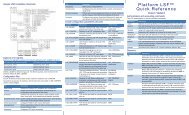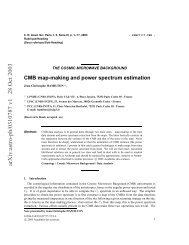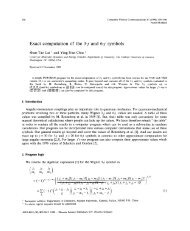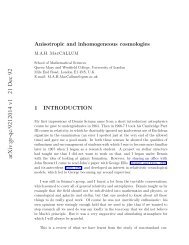Chaotic new inflation and primordial spectrum of adiabatic ... - iucaa
Chaotic new inflation and primordial spectrum of adiabatic ... - iucaa
Chaotic new inflation and primordial spectrum of adiabatic ... - iucaa
Create successful ePaper yourself
Turn your PDF publications into a flip-book with our unique Google optimized e-Paper software.
<strong>Chaotic</strong> <strong>new</strong> <strong>inflation</strong> <strong>and</strong> <strong>primordial</strong> <strong>spectrum</strong> <strong>of</strong> <strong>adiabatic</strong> fluctuationsJun’ichi YokoyamaYukawa Institute for Theoretical Physics, Kyoto University, Kyoto 606-8502, JapanReceived 24 December 1998; published 23 April 1999In a number <strong>of</strong> scalar potentials with an unstable local maximum at the origin, chaotic <strong>inflation</strong> is followedby <strong>new</strong> <strong>inflation</strong> if model parameters <strong>of</strong> the potential are appropriately chosen. We calculate the <strong>spectrum</strong> <strong>of</strong><strong>adiabatic</strong> fluctuations in such a double <strong>inflation</strong> model <strong>and</strong> show that it is possible to realize an almostscale-invariant <strong>spectrum</strong> with a sharp cut<strong>of</strong>f on a superhorizon scale, which may be favored observationally,<strong>and</strong> a tilted <strong>spectrum</strong> with the spectral index n eff 0.95 on large scales. S0556-28219900112-5PACS numbers: 98.80.CqPHYSICAL REVIEW D, VOLUME 59, 107303It is now commonly believed that the large-scale homogeneity<strong>and</strong> isotropy observed in the Universe were realizedas a result <strong>of</strong> a stage <strong>of</strong> accelerated expansion or <strong>inflation</strong> inthe early universe 1. The original model <strong>of</strong> <strong>inflation</strong> 2 wasbased on a first-order phase transition <strong>of</strong> a Higgs field ingr<strong>and</strong> unified theories GUTs. This model, however, failedbecause it could not achieve a graceful exit to the Friedmannera <strong>and</strong> the resultant universe turned out to be too inhomogeneous.Soon after that, the <strong>new</strong> <strong>inflation</strong> model 3 was proposedin which an <strong>inflation</strong>ary stage was realized as the Higgs fieldrolls down its Coleman-Weinberg 4 potential slowly towarda global minimum during a second-order phase transition.It was shown that long-wave <strong>primordial</strong> density fluctuationswere generated out <strong>of</strong> quantum fluctuations <strong>of</strong> thescalar field in this slow roll over de Sitter stage 5. Unfortunately,however, it was observed that <strong>new</strong> <strong>inflation</strong> drivenby a GUT Higgs field suffered from several problems such astoo large density fluctuations <strong>and</strong> too short duration <strong>of</strong> <strong>inflation</strong>.But the most serious problem was that the initial conditionrequired for <strong>new</strong> <strong>inflation</strong>, namely, localization <strong>of</strong> thescalar field around the origin could not be realized by thepresumed mechanism, or high-temperature symmetry restoration,because the universe could not have been in thermalequilibrium in its very early stage due to the rapid cosmicexpansion 6.The chaotic <strong>inflation</strong> model 7 was proposed to resolvethe above mentioned problems. This model assumes the existence<strong>of</strong> an <strong>inflation</strong>-driving <strong>inflation</strong> field, , with a potential,V, which has a gentle slope up to well above thePlanck scale, M Pl . At the Planck time, t Pl , when classicaldescription <strong>of</strong> spacetime becomes possible, the universe isexpected to be in a chaotic state <strong>and</strong> the only constraint imposedon the initial distribution <strong>of</strong> the inflaton field is thatboth kinetic or gradient energy density <strong>and</strong> potential energydensity should be smaller than the Planck density, M 4 Pl .Hence it is natural to assume that has an amplitude muchlarger than M Pl in some domain. Then <strong>inflation</strong>ary expansionsets in due to its large potential energy density as gradually rolls down to a minimum.The amplitude <strong>and</strong> the <strong>spectrum</strong> <strong>of</strong> density <strong>and</strong> curvaturefluctuations generated in this model are also calculated in thest<strong>and</strong>ard way. Let us write the perturbed metric in the longitudinalgauge,ds 2 „12x,t…dt 2 a 2 t„12x,t…dx 2 ,where a(t) is the scale factor <strong>and</strong> we use the notation <strong>of</strong> 8for the perturbation variables. Decomposing them to Fouriermodes as k d3 x2 3/2 x,te ikx ,we can calculate the root-mean-square rms amplitude <strong>of</strong> k k at the time k mode reenters the Hubble radius inthe post<strong>inflation</strong>ary universe as k 2 1/2 f H k˙ t k fH 2, 2k 3 ˙ t kwhere k is the Fourier component <strong>of</strong> long-wave fluctuations<strong>of</strong> a massless scalar field in the de Sitter spacetime withthe Hubble parameter H, <strong>and</strong> f 3/5(2/3) in the matter-radiation- dominated stage 5. The right-h<strong>and</strong> side <strong>of</strong> theabove equality should be evaluated at tt k whena(t k )H(t k )k during <strong>inflation</strong>. By multiplying the phasespacefactor, the rms amplitude <strong>of</strong> curvature perturbation onthe comoving scale r2/k is given by r 2 H 2 f f tk 2˙ k , 4t k<strong>and</strong> the effective spectral index is defined by123n eff d ln k 2 4. 5d ln kSince both H <strong>and</strong> ˙ are slowly varying during <strong>inflation</strong> wefind n eff 1 in most cases, which is the Harrison-Zel’dovich<strong>spectrum</strong> 9. For example, in the chaotic <strong>inflation</strong> modeldriven by a quartic potential, V 4 /4, we find n eff0.95 on the comoving scales corresponding to the largescalestructures today.In comparing various observational data <strong>of</strong> the anisotropyin cosmic microwave background radiation CMB <strong>and</strong> <strong>of</strong>the large-scale structures LSS with theoretical models 10,a single power-law <strong>primordial</strong> fluctuation <strong>spectrum</strong> with a0556-2821/99/5910/1073034/$15.0059 107303-1©1999 The American Physical Society
BRIEF REPORTS PHYSICAL REVIEW D 59 107303constant power index is usually assumed. In particular, modelswith n1 are preferred as predicted from <strong>inflation</strong>. Infact, however, a number <strong>of</strong> mechanisms has been proposedto generate more complicated non-scale-invariant fluctuationswithin <strong>inflation</strong>ary cosmology. For example, Hodges<strong>and</strong> Blumenthal 11 argued possibility to generate arbitrary<strong>spectrum</strong> <strong>of</strong> <strong>adiabatic</strong> fluctuations by making use <strong>of</strong> weak dependence <strong>of</strong> asM PlV3/2 3 V , 6in the slow roll over regime. While they depicted variousshapes <strong>of</strong> nontrivial spectra, few <strong>of</strong> the corresponding potentialshave a plausible form in particle physics. Other possiblemechanisms for generation <strong>of</strong> non-scale-invariant spectra includemixture <strong>of</strong> <strong>adiabatic</strong> <strong>and</strong> isocurvature fluctuations,which requires multiple fluctuating fields 12,13, <strong>and</strong> multiplestages <strong>of</strong> <strong>inflation</strong> with multiple inflatons or combination<strong>of</strong> an inflaton <strong>and</strong> higher-order gravity 14.Recently, we proposed a novel model <strong>of</strong> double <strong>inflation</strong>which contains only one source <strong>of</strong> <strong>inflation</strong> 15. That is, weobserved that in a number <strong>of</strong> scalar potentials with an unstablelocal maximum at the origin chaotic <strong>inflation</strong> is followedby <strong>new</strong> <strong>inflation</strong> if model parameters are appropriatelychosen. The primary concern <strong>of</strong> the previous paper was togenerate a <strong>spectrum</strong> <strong>of</strong> density fluctuations which has a sharppeak on a specific scale in order to allow significant formation<strong>of</strong> <strong>primordial</strong> black holes PBHs on the correspondingmass scale. We have found a successful model to explainmassive compact halo objects MACHOs in terms <strong>of</strong> thesePBHs by specifying some <strong>of</strong> the model parameters with theaccuracy <strong>of</strong> eight digits, because the abundance <strong>of</strong> PBHs isexponentially sensitive to the peak amplitude <strong>of</strong> fluctuations16.In the present article we investigate a more generic feature<strong>of</strong> the <strong>spectrum</strong> <strong>of</strong> <strong>adiabatic</strong> fluctuations generated inthis model <strong>and</strong> discuss its relevance to CMB anisotropy <strong>and</strong>LSS.We adopt the Coleman-Weinberg potential,V 4 4 ln v 1 4 16 v4 .This potential can drive chaotic <strong>inflation</strong> for emax(M Pl /8,4v), <strong>and</strong> <strong>new</strong> <strong>inflation</strong> around 0. Kung<strong>and</strong> Br<strong>and</strong>enberger 17 studied the initial distribution <strong>of</strong> ascalar field with a double-well potential <strong>and</strong> concluded thatchaotic <strong>inflation</strong> is much more likely than <strong>new</strong> <strong>inflation</strong>.Thus we also start with chaotic <strong>inflation</strong> with M Pl . Afterchaotic <strong>inflation</strong>, the scalar field starts oscillation around v if v is too large, or it overshoots the symmetric state0 <strong>and</strong> approaches the other minimum v if v is toosmall. If v is appropriately chosen at an intermediate value,on the other h<strong>and</strong>, it can spend a long enough time near theorigin <strong>and</strong> then slow roll over <strong>new</strong> <strong>inflation</strong> can set in, whichends up with either v or v depending on the sign<strong>of</strong> when classical slow roll over regime begins.7We numerically solve equations <strong>of</strong> motion <strong>of</strong> the homogeneouspart <strong>of</strong> the fields,H aȧ 2¨ 3H˙ V0,2 823M Pl8˙ 2V, 92with the above initial condition. As a result we find that <strong>new</strong><strong>inflation</strong> can be realized after chaotic <strong>inflation</strong> if we take v0.22M Pl . More precisely, the number <strong>of</strong> e-folds <strong>of</strong> <strong>new</strong><strong>inflation</strong>ary expansion, N <strong>new</strong> , with ḢH 2 is larger than 10for v0.2201M Pl 0.2259M Pl , <strong>and</strong> it satisfies N <strong>new</strong> 60for v0.2223M Pl 0.2239M Pl . In the latter case, the comovingscales which leave the Hubble radius during chaotic<strong>inflation</strong> are stretched beyond the current Hubble horizon<strong>and</strong> hence they are unobservable today.After <strong>new</strong> <strong>inflation</strong> settles to the positive potential minimumv if v0.2232M Pl <strong>and</strong> to the negative potentialminimum v if v0.2231M Pl . If we take even smallervalues <strong>of</strong> v, orv0.1066M Pl , will return to the positivepotential minimum after one oscillation around the negativepotential minimum. New <strong>inflation</strong> is possible when approachesthe origin after crossing v if v0.1064M Pl0.1066M Pl . Here we have assumed that dissipates itsenergy density only through cosmic expansion. Below weconcentrate on the cases where <strong>new</strong> <strong>inflation</strong> takes placewhen moves to the negative direction <strong>and</strong> relaxes to v without returning to v.The above results are independent <strong>of</strong> the initial conditionas long as has large enough initial value so that the systemrelaxes to the slow roll over chaotic <strong>inflation</strong> solution 7.They are also independent <strong>of</strong> the coupling parameter . Infact, defining Ṽ 1 V <strong>and</strong> a <strong>new</strong> time variable 1/2 t, the equations <strong>of</strong> motion 8 <strong>and</strong> 9 are rewritten as 3H˜ Ṽ0,10a2 823M Pl 2.211H˜ 2 a Obviously, the system is now independent <strong>of</strong> . The amplitude<strong>of</strong> fluctuation, on the other h<strong>and</strong>, is written in terms <strong>of</strong>the rescaled variables asH2 H˜ 2 1/22˙ 2 ,12so it is proportional to 1/2 .Figure 1 depicts the amplitude <strong>of</strong> fluctuation (r2/k) as a function <strong>of</strong> the natural logarithm <strong>of</strong> the comovingwave number, N(k)ln(k/k *), for various values <strong>of</strong> vwith 10 14 . Here k *is the comoving wave number leavingthe Hubble radius at the end <strong>of</strong> chaotic <strong>inflation</strong>. In thisfigure fluctuations on the left <strong>of</strong> the dip are due to chaotic<strong>inflation</strong> <strong>and</strong> those on the right are from <strong>new</strong> <strong>inflation</strong>. Thevalue <strong>of</strong> N(k) at the right end <strong>of</strong> each curve, N f , where 107303-2
BRIEF REPORTS PHYSICAL REVIEW D 59 107303FIG. 1. Spectrum <strong>of</strong> perturbation,(r), generated in the chaotic<strong>new</strong> <strong>inflation</strong> model for 10 14 . Fluctuations generatedduring chaotic <strong>inflation</strong> are practicallydegenerate for all v’s consideredhere.sharply declines, is practically equal to N <strong>new</strong> for each v. Theamplitude <strong>of</strong> fluctuation (r) on the current Hubble radiuscan be obtained from the value at N(k)N f 60 <strong>and</strong> that onthe comoving scale corresponding to 1h 1 Mpc today fromN(k)N f 52 for each v. Here we have used the followingrelation between current length scale r <strong>and</strong> N(k):r310 3 h 1 Mpc 141/4expN10 f 60Nk,13where efficient reheating is assumed after <strong>new</strong> <strong>inflation</strong> withv0.22M Pl <strong>and</strong> h0.7.Let us summarize our main result shown in Fig. 1. Firstfor v0.20M Pl , the number <strong>of</strong> e-folds during <strong>new</strong> <strong>inflation</strong>is less than unity <strong>and</strong> the density fluctuation is entirely due tochaotic <strong>inflation</strong>. For 0.2223M Pl v(0.2239M Pl ), on thecontrary, all the currently observable scales have left theHubble radius during <strong>new</strong> <strong>inflation</strong> regime. The case withv0.22235M Pl is particularly interesting because there is asharp decline in the <strong>spectrum</strong> <strong>of</strong> fluctuation just above thecurrent Hubble radius. In fact, it has been argued in the literature18 that such a <strong>spectrum</strong> fits the observation <strong>of</strong> theanisotropy <strong>of</strong> CMB by the Cosmic Background ExplorerCOBE better than the conventional scale-invariant <strong>spectrum</strong>.For 0.20M Pl v0.2223M Pl , both chaotic <strong>inflation</strong> <strong>and</strong><strong>new</strong> <strong>inflation</strong> contribute to density fluctuations within thecurrent Hubble radius. In most cases, the <strong>spectrum</strong> <strong>of</strong> fluctuationson scales probed by LSS <strong>and</strong> CMB, namely, thosecorresponding to the comoving scales between N(k)N f52 <strong>and</strong> N f 60 in the unit <strong>of</strong> the horizontal axis in Fig. 1,can be fit by a power law. But models with v0.2222M Pl0.2223M Pl should be ruled out, because they produce alarge dip in the <strong>spectrum</strong> <strong>of</strong> fluctuations on scales probed byLSS <strong>and</strong> CMB. Table I shows effective spectral index obtainedon these scales. As is seen there we can realize a tilted<strong>spectrum</strong> <strong>of</strong> <strong>adiabatic</strong> fluctuations with the spectral indexn eff 0.95. Previously a power-law <strong>spectrum</strong> with a fixed indexn1 has been known to be realized with a scalar fieldwith an exponential potential 19,Vexp 1n 16, 142n M Plwhere <strong>inflation</strong> is <strong>of</strong> power law, a(t) t (2n)/(1n) . Ourmodel provides another mechanism to produce a tilted <strong>spectrum</strong>within a renormalizable theory in the Einstein gravity.In addition, this model also predicts a peak <strong>of</strong> densityfluctuation on a smaller scale corresponding to the comovinghorizon scale at the onset <strong>of</strong> slow-roll <strong>new</strong> <strong>inflation</strong>. In TableI we have also shown the comoving mass scales <strong>of</strong> nonrelativisticmatter corresponding to the peak, taking the currentdensity parameter 0 0.3 <strong>and</strong> h0.7. For realistic values<strong>of</strong> the spectral index n eff 0.8 on large scales 20, thesemass scales are too small to leave any cosmological effects.So far we have assumed that the homogeneous part <strong>of</strong> theinflaton traces the classical trajectory <strong>and</strong> calculated the<strong>spectrum</strong> <strong>of</strong> <strong>adiabatic</strong> fluctuations based on the formula 4TABLE I. Effective spectral index, n eff , on comoving scales r310 3 h 1 Mpc <strong>and</strong> 1h 1 Mpc <strong>and</strong> the comoving mass scale atthe peak <strong>of</strong> fluctuations as a function <strong>of</strong> v.v n eff (310 3 h 1 Mpc) n eff (1h 1 Mpc) Peak mass0.20M Pl 0.95 0.940.2200M Pl 0.94 0.92 210 53 M 0.2210M Pl 0.93 0.91 110 45 M 0.2215M Pl 0.91 0.89 410 35 M 0.2220M Pl 0.85 0.78 110 15 M 0.2221M Pl 0.80 0.69 410 9 M 0.2222M Pl 0.65 6M 0.2223M Pl 0.94 310 12 M 107303-3
BRIEF REPORTS PHYSICAL REVIEW D 59 107303derived with the slow-roll approximation. Here we discussplausibility <strong>of</strong> the above treatment.First quantum fluctuations generated during the precedingchaotic <strong>inflation</strong> stage may affect the duration <strong>of</strong> <strong>new</strong> <strong>inflation</strong>.One can estimate the fluctuation <strong>of</strong> the number <strong>of</strong>e-folds <strong>of</strong> slow-roll <strong>new</strong> <strong>inflation</strong>, N <strong>new</strong> ,as13N <strong>new</strong>N <strong>new</strong>2 s s.15Here s is the field amplitude when slow-roll approximationbecomes valid, which is nothing but the value <strong>of</strong> at thepeak <strong>of</strong> . s is the amplitude <strong>of</strong> fluctuation at this epochwithin the comoving scale corresponding to the current horizon.It is typically significantly smaller than H(4M Pl )20 1/2 M Pl . For 10 14 we numerically findthat s ranges between s 10 2 M Pl <strong>and</strong>310 3 M Pl for v0.22M Pl 0.2224M Pl . Thus we findN <strong>new</strong> 1 for the cases <strong>of</strong> our interest.Next we evaluate the correction factor, C, to be multipliedto Eq. 4, which accounts for the deviation from the slowrollapproximation. This factor could be important since theinflaton is not necessarily slowly rolling in the beginning <strong>of</strong><strong>new</strong> <strong>inflation</strong> <strong>and</strong> in the final stage <strong>of</strong> both chaotic <strong>and</strong> <strong>new</strong><strong>inflation</strong>. It has been given by Stewart <strong>and</strong> Lyth 21 asC12ln 2b2, Ḣ ¨, 2H H˙ ,16where b is the Euler-Mascheroni constant <strong>and</strong> so 2ln 2b0.7296. As a result <strong>of</strong> numerical calculation, we find0C10.03 until the end <strong>of</strong> chaotic <strong>inflation</strong>. In the beginning<strong>of</strong> <strong>new</strong> <strong>inflation</strong> C deviates from unity considerably<strong>and</strong> the slow-roll formula 4 tends to overestimate the amplitude<strong>of</strong> fluctuation. However, at the peak <strong>of</strong> fluctuation,C1 is already as small as 0.03. After that Eq. 4 is fairlyaccurate until (r) starts to decline sharply at the end <strong>of</strong> <strong>new</strong><strong>inflation</strong>. Thus for all our practical purposes the slow-rollformula 4 is sufficient.In summary, we have calculated the <strong>spectrum</strong> <strong>of</strong> <strong>adiabatic</strong>fluctuation generated in the chaotic <strong>new</strong> <strong>inflation</strong> model inducedby a Coleman-Weinberg potential. As a result we haveshown that, depending on the choice <strong>of</strong> the model parameterv, this model can realize an almost scale-invariant <strong>spectrum</strong>with a sharp cut<strong>of</strong>f on a super horizon scale, which may befavored by COBE observation <strong>of</strong> CMB anisotropy, <strong>and</strong> atilted <strong>spectrum</strong> with the spectral index n eff 0.95 which maybe desirable for successful structure formation.This work was partially supported by the Japanese Grantin Aid for Science Research Fund <strong>of</strong> the Monbusho No.09740334 <strong>and</strong> ‘‘Priority Area: Supersymmetry <strong>and</strong> UnifiedTheory <strong>of</strong> Elementary Particles #707.’’1 For a review <strong>of</strong> <strong>inflation</strong> see, e.g., A. D. Linde, Particle Physics<strong>and</strong> Inflationary Cosmology Harwood, Chur, Switzerl<strong>and</strong>,1990; K. A. Olive, Phys. Rep. 190, 181 1990; D. H. Lyth<strong>and</strong> A. Riotto, hep-ph/9807278.2 A. H. Guth, Phys. Rev. D 23, 347 1981; K. Sato, Mon. Not.R. Astron. Soc. 195, 467 1981.3 A. D. Linde, Phys. Lett. 108B, 389 1982; A. Albrecht <strong>and</strong> P.J. Steinhardt, Phys. Rev. Lett. 48, 1220 1982.4 S. Coleman <strong>and</strong> E. Weinberg, Phys. Rev. D 7, 788 1973.5 S. W. Hawking, Phys. Lett. 115B, 295 1982; A. A. Starobinsky,ibid. 117B, 175 1982; A. H. Guth <strong>and</strong> S-Y. Pi, Phys.Rev. Lett. 49, 1110 1982.6 J. Ellis <strong>and</strong> G. Steigman, Phys. Lett. 89B, 186 1980.7 A. D. Linde, Phys. Lett. 129B, 177 1983.8 H. Kodama <strong>and</strong> M. Sasaki, Prog. Theor. Phys. Suppl. 78, 11984.9 E. R. Harrison, Phys. Rev. D 1, 2726 1970; Ya. B.Zel’dovich, Mon. Not. R. Astron. Soc. 160, 1p1972.10 See, e.g., E. Gawiser <strong>and</strong> J. Silk, Science 280, 1405 1998.11 H. M. Hodges <strong>and</strong> G. R. Blumenthal, Phys. Rev. D 42, 33291990.12 A. D. Linde, Phys. Lett. 158B, 375 1985; L. A. K<strong>of</strong>man <strong>and</strong>A. D. Linde, Nucl. Phys. B282, 555 1987.13 J. Yokoyama, Astron. Astrophys. 318, 673 1997.14 L. F. K<strong>of</strong>man, A. D. Linde, <strong>and</strong> A. A. Starobinsky, Phys. Lett.157B, 361 1985; J. Silk <strong>and</strong> M. S. Turner, Phys. Rev. D 35,419 1987; R. Holman, E. W. Kolb, S. L. Vadas, <strong>and</strong> Y.Wang, Phys. Lett. B 269, 252 1991; D. Polarski <strong>and</strong> A. A.Starobinsky, Nucl. Phys. B385, 623 1992; Phys. Rev. D 50,6123 1994; S. Gottlöber, J. P. Muecket, <strong>and</strong> A. A. Starobinsky,Astrophys. J. 434, 417 1994.15 J. Yokoyama, Phys. Rev. D 58, 083510 1998.16 B. J. Carr, Astrophys. J. 201, 11975.17 J. H. Kung <strong>and</strong> R. H. Br<strong>and</strong>enberger, Phys. Rev. D 42, 10081990.18 Y.-P. Jing <strong>and</strong> L.-Z. Fang, Phys. Rev. Lett. 73, 1882 1994;L.-Z. Fang <strong>and</strong> Y.-P. Jing, Mod. Phys. Lett. A 11, 15311996; A. Berera, L.-Z. Fang, <strong>and</strong> G. Hinshaw, Phys. Rev. D57, 2207 1998.19 F. Lucchin <strong>and</strong> S. Matarrese, Phys. Rev. D 32, 1316 1985.20 C. L. Bennet et al., Astrophys. J. Lett. 464, L11996.21 E. D. Stewart <strong>and</strong> D. H. Lyth, Phys. Lett. B 302, 171 1993.107303-4


